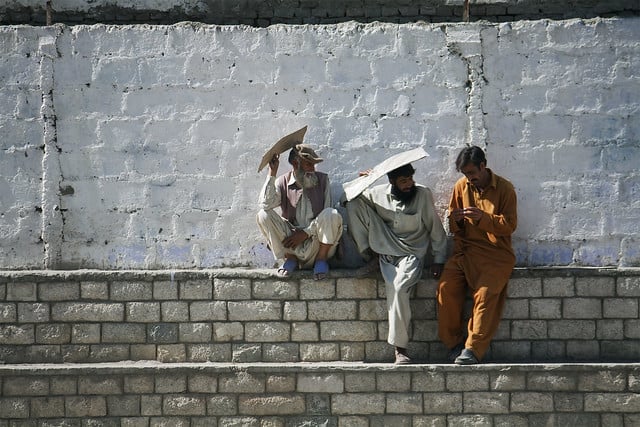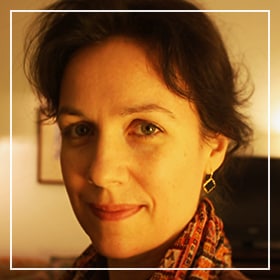Drawing on fieldwork undertaken between 2004 and 2013 in Gilgit Town, the multi-sectarian capital of the Gilgit-Baltistan region of northern Pakistan, this brief explores how, even while they work under the aegis of a “avowedly nondenominational” (Miller 2015: 4; see Khan 2010: 66), “non-communal” (AKRSP 1990: 3) Muslim humanitarianism that professes to uplift and protect insaaniyat – or, humanity itself – philanthropic actors can sometimes engage instead in practices that differentiate and exclude prospective beneficiaries on the basis of sect.
Since 1982, Muslim humanitarianism in Gilgit-Baltistan has taken the principle form of the Aga Khan Development Network – or, AKDN – and its multiple agency auspices. Helmed programmatically, politically, and spiritually from its Swiss and later French headquarters His Highness Prince Aga Khan – or, the Hazir Imam as he is known to his followers, members of the Nizari Isma’ili Shi’i branch of Islam – the AKDN’s track record in Gilgit-Baltistan is one of incredible initial fortunes, though these gave way to a more diminished project by the mid-2000s.
Through the medium of microfinance and agriculture entities such as the Aga Khan Rural Support Programme (AKRSP), the Aga Khan Education Services’ (AKES) schools and teacher training, and the Aga Khan Health Services’ (AKHS) clinics, hospitals, and health outreach, AKDN implemented a broad-array of infrastructural and community-based development projects. The story of its agencies’ prodigious outputs in Gilgit-Baltistan serves as a commendable and much-touted example of the power of Aga Khan and his Imamat, or community of believers, to harness Ismaili faith and sociality as a means to spark and sustain change, and re-craft local communities in ways that were recognizably more “modern” and “civilized”: literate, economically productive, and socially and politically empowered.
From their outset, AKDN agencies capitalized on and scripted into their humanitarian operations a broad array of the uniquely Ismaili “moral, meanings, obligations and sentiments” (Miller 2015: 34) cherished by its Ismaili beneficiaries, including a sect-specific communitarian ethos. These gestures helped AKDN’s agencies to localize and render familiar the otherwise-global humanitarian principles and ethics imagined to more closely hold local-level development actors’ and beneficiaries’ to their mandates, and better actualize Gilgit-Baltistan’s Ismailis’ simultaneously-“spiritual and material development” (Miller 2015: 34).
In the interests of ensuring equity and peace between Ismailis, Shias, and Sunnis, and fulfilling the AKDN’s secular and pluralistic mandate, its operational boundaries were early on expanded to include non-Ismailis as development partners.
However, informed as its agencies were first with Ismaili and only then more “generally Islamic concepts” (Miller 2015: 4), AKDN’s humanitarianism was experienced by enrolled and prospective beneficiaries as “inseparably entwined with [Ismailis’] spiritual and moral aspirations” (Ibid), and “explicitly” rather than implicitly religious (see Miller 2015: 4). Rather than acknowledge the distinctively Ismaili “moral logics” inherent to its interventions, or the “real and potential exclusions” these and the singularly “special relationship between Isma’ilis and the AKDN” (Miller 2015: 4-5) gave rise, many AKDN employees, the majority of whom were Ismailis, affirmed “pluralism [as] a central pillar of AKDN’s ethical framework” (AKDN 2014a in Mostowlansky 2016: 233).
In Gilgit-Baltistan, though, pluralism was not necessarily reflected by the social and spatial distribution of AKDN agencies’ initiatives, with Ismaili communities’ boundaries repeated in and reflected by, interventions’ contouring and emplacement (Manetta and Steinberg n.d.: 21; World Bank 2002, Wood 2006). Nor was pluralism always reflected by the content and tenor of its inter-sectarian humanitarian engagements. Sunnis especially were rarely included as administrators and decision-makers, and AKDN’s programmatic consultations with Sunni and Shia Village Organization (VO) members were infrequent, when Shia and especially Sunni VOs existed at all. External evaluations found AKDN mobilization drives focused less on Shia and Sunni communities, meaning their specific and sometimes uniquely different development needs and ambitions often went unaddressed (see McGuinness et al, 2010).
Agencies’ employees explained Shias and Sunnis’ comparatively diminished presence as being because they were “poorly receptive” and even “antagonistic” to AKDN’s developmentalist and humanitarian outreach. Having witnessed such realities during my employment with AKRSP in 1998, I knew these claims held true, but only to a degree. Indeed, in my subsequent research, AKDN’s assertions were contested by the majority of my Sunni and Shia interlocutors, who self-described as “eager” and even “desperate” for the chance to participate in and avail themselves of the benefits of, AKDN interventions, and contradicted by Sunnis and Shias’ community-based efforts to petition its agencies for coverage, some of which I had been party to.
My ethnography found Sunnis and Shias’ estrangements not simply yielded by community-side “suspicion”, “rejection” (Settle 2012: 392), or “hostility”. Nor were they only the result of organizational “blind spots” (2014), as Salmaan Keshavjee qualifies the Aga Khan Foundation’s operational oversights and community-level inattentions in other parts of Central Asia.
Sunni and Shia interlocutors described their under-inclusion or bypassing by AKDN agencies as evidence, too, of something more deliberate: of ‘biases’ (see Settle 2012: 394) and neglect (see Settle 2010: 25) that, when put into practice and exchange, were at-distinct odds with AKDN’s professed humanitarian impulse. Their claims were corroborated by the fact that, in my interviews with them, a number of AKDN personnel’s initial declarations that their work was fuelled by an apolitical, secular, and non-sectarian altruism (Settle 2010: 23, 32) gave way to sectarian, political, and sometimes-wholly prejudicial assessments of the Shia and Sunni ‘others’ in their midst, and, as my brief explores, Sunnis perhaps most of all (see Ali and Akhunzada 2015: 15, Hunzai 2013: 8).
The distance between Sunnis and Ismailis was attributed as much to cultural and ethnic as religious differences, with Sunnis sharing far less Islamic doctrinal interpretation, systems of leadership, and ritual practices in common with Ismailis than Shias. Moreover, AKDN personnel worked, then as now, against the backdrop of internecine discord and violence. While Shia-Sunnis enmities have been significantly greater, many Ismailis described also experiencing discrimination and sometimes violence, which informed some of their concerns for and less laudatory opinions about Sunnis, even if Shias could be equivalently responsible for such acts. My brief seeks not to negate AKDN agencies’ innumerable strengths and achievements, but unsettle their claims concerning the persons theorized as being their prospective beneficiaries, yet who appeared infrequently if at all as part of their operations.

Gilgit Medical Center
By way of a focus on the Aga Khan Health Services, my brief offers vignettes of the ways ‘at-odds’ impulses were structurally embedded, affective, and quotidian; swept into humanitarian exchanges, and helping to explain agencies’ results. In discussing the ways that sectarianism could be imbricated with AKHS’s on-the-ground workings, I foreground the ways that many Sunnis, on whom the majority of my research since 2004 has focused, came to be estranged from the low-to medium-cost Gilgit Medical Center, the 50-bed facility that until 2014 served as AKHS’s regional headquarters and its flagship hospital. My work at the hospital was the result of a larger ethnographic project, which explored how Shia‐Sunni hostilities contributed to Sunnis’ marginalization from Gilgit Town’s government hospitals, located as they were in Shia enclaves, and led to the worsening of their already-high morbidity and mortality ratios (see Varley 2010, 2016). Unable to safely access public sector facilities during Shia-Sunni strife, the Gilgit Medical Center was a clinically more effective and imaginably more ‘neutral alternative’.
By contrast to its proponents’ claims that the hospital was universally accessible, and posted notifications at the facility that “political talk” was proscribed, a considerable number of Sunni interlocutors’ relayed how, in the course of seeking and receiving care, they felt they had been discriminated against by Ismaili staff, as it took the form of comments intended to earmark Sunnis’ less desirable differences from Ismailis, and not-always subtle forms of maltreatment meted out by Ismaili patients and attendants; with some abuses witnessed but not also intervened upon by attending staff. In sharing the stories of their time at the hospital, maternity patients spoke of the ways that the care they had received often compared unfavorably against the attention shown to Ismailis; in so doing, Sunnis confirmed the power of poor handling, perceived or actual, to drive them away from the hospital and its services. Sunnis’ sometimes-strident or disruptive efforts to protest or pushback against what they felt were the prejudicial conditions of care risked being recast as evidence of their “difficult nature”. (To this end, many Sunni interlocutors admitted that, worried for the possibility of mistreatment, they could be over-reactive, defensive, and unduly provocative.) One nurse relayed how, “Sunnis are more closed-minded, and they are ‘pushier’. They ask a lot of questions and interfere.”
In ways that inadvertently corroborated Sunnis’ claims of differential treatment, a number of AKHS interlocutors shared their concerns for the “challenges” posed by Sunni patients on the one hand, and the Sunni community’s “incapacity” and “extremism” on the other.
Common to many accounts were assertions that Sunnis were inherently “backwards”. In my work in the Outpatient Ward, poorer women’s bodily condition, and impaired obstetric health especially, were often conveyed as being metaphoric for the Sunni body politic overall. One administrator went further; proposing that Sunnis’ “incivility” and “wickedness” could be chalked up to “genetic” causes and was, therefore, unmanageable and inescapable. They argued that these more ‘intractable’ qualities confirmed Sunnis’ poor suitability both as development partners and recipients of its largesse, insofar as it had been theoretically extended to them. In advancing these claims, many personnel raised the specter of ‘tribal violence’ in neighbouring Diamer District and Khyber-Pakthunkhwa Province, and the sometimes spectacular acts of violence Sunni militants in these areas had inflicted, including the mass killings in 2011 and 2012 of Shias traveling south to Islamabad. When pressed, some eventually acknowledged that their broad-brush approaches invoked extremisms that had little to no bearing on the behaviour of Sunni patients coming from within Gilgit Town, the vast majority of whom shared Ismailis’ concerns for the dangers posed by tribalism and fanaticism in other regions of Gilgit-Baltistan, or themselves had fled radicalism and strife in those districts, and were socially and economically more alike the hospital’s Ismaili employees and patients than different.
When asked why Sunnis comprised the smallest percentage of the hospital’s in‐town patients, a number of employees denied the possibility that sectarianism at the facility contributed to Sunni patients’ choosing other hospitals. Instead, Sunnis’ under‐use of the hospital was attributed to their “lack of awareness” about its services. However, Sunni interlocutors were universally knowledgeable about the Gilgit Medical Center, and many expressed a deep appreciation for its healthcare providers’ expertise, and safer, higher quality treatments they provided. Personnel also referred to Sunnis’ “religious zealotry”, and their animosities for Ismailis and the Aga Khan in particular, about which they were not far wrong. However, theirs was a disdain expressed less for Ismailis’ religious beliefs and practices than the instrumentalization of AKDN agencies for “political” rather than only philanthropic purposes, and their discontent with an Ismaili-identified humanitarianism that professed care for all, yet under-engaged Sunnis, who were already poorly supported at governmental and non-governmental levels. AKHS’s operations across Gilgit-Baltistan, for instance, served a predominantly Ismaili and Shia patient base.
In making sense of their marginalization, Sunni interlocutors hypothesized that AKDN and its agents were able to preserve humanitarianism’s symbolic capital and material largesse for ‘their own’, and, in so doing, facilitate Ismailis’ collective uplift in socio-economic and political terms all. They pointed out how the “advancement” and “progress” engendered by nearly forty years of concentrated humanitarianism yielded definitively political advantages and capital.
A more educated, prosperous, and healthier Ismaili body politic was not only better positioned to emplace its agents and advocates in more political terrain, including in the region’s public sector. It was also better equipped to pursue and defend its own interests. Humanitarian exclusions were also broadly understood – not only by Sunnis, but also a number of Shia and Ismaili interlocutors – as enabling Ismailis to distinguish themselves from and compete against, their Sunni and Shia “sister communities”, and gain leverage over Gilgit-Baltistan’s key resources. With their efforts concentrated in Ismaili communities, AKDN agencies achieved a dramatic but also selective uplift that was left largely unchallenged by its donors, and significant upticks in its beneficiaries’ social welfare and health indicators. The AKHS’s successes in Ismaili communities, though, have yielded health disparities and, by relation, resentments of such a magnitude that many interlocutors hypothesized they may have helped fuel inter-sectarian enmities and conflict.
In reporting to donors and stakeholders, AKDN agencies typically emphasized either the success of their pluralistic efforts, or, in explaining and legitimating uneven inclusion, relied on explanations that foregrounded Sunnis and Shias’ disinterest or intransigence. In such tellings, it was not that that Sunnis and Shias were discouraged or denied, but, rather, that they themselves rejected the development equation. No matter the rhetoric, disconnect between what AKDN’s agencies reported, and what the communities within their operational reach experienced, was not entirely unnoticed. Several external evaluations, including two by the World Bank (1995, 2002; McGuinness et al, 2010; see also Miller 2015), confirmed the challenges AKDN faced initially establishing traction with more conservative Sunni and Shia communities. Conversely, they also established Shias and Sunnis’ willingness and ability to join interventions, and, in so doing, generated evidences that destabilized AKDN narratives and helped fill in their gaps.
Conclusion
Even though AKDN agencies such as AKHS were configured and publicly relayed as projects intended for and available to all, a substantial number of Sunni interlocutors characterized their operations as sources and mechanisms of tacit sectarian distancing and exclusion. As I found, not all exclusions were achieved through inequitable distributions or denials; at the Gilgit Medical Center, they were made possible, too, through the affective quality of care. Rather than sectarian preferences and prejudices being separable from the humanitarian project, my interlocutors revealed them as entangled with the formulation and execution of humanitarianism itself, with Sunnis’ marginalization revealing AKDN as an undeniably utopic but also sect-specific visioning of regional development and community welfare.
It wasn’t entirely surprising, then, that so many Sunni interlocutors experienced AKDN agencies’ day-to-day operations and outreach to non-Ismailis in particular, as politically fraught and morally bifurcated; marked by the tension between the universalizing and inclusive nature of its humanitarian mandate, and the particularizing and exclusionary goals of the persons tasked with seeing it through. For them, humanitarianism emerged as internally animated by inconsistencies in its agents’ pursuit of orthodoxy and orthopraxy – or, right belief versus right practice (Goguen and Bolten 2017) – such as it took the form of discrepancies between humanitarian actors’ professed goal to support all irrespective of sect, and their sometimes more restrained or limited commitment to fulfill the same.
Through ethnography that attends to those at humanitarianism’s distal edges, we gain insights into the ways that interventions can be experienced not as uniformly benevolent, but prejudicial and neglectful. Such a focus helps us better apprehend humanitarianism’s inconsistencies, insofar as on-the-ground practices can deviate from institutional ethics, and its incoherence from the perspective of those who believe in pluralistic mandates, but find themselves rebuffed or sidelined because of their difference. Nested within ostensibly ethical humanitarian projects, other kinds of impulses may be at-work; in exploring them, anthropologists encounter humanitarianism’ alter ego, such as it can consist of less humane and less reported – or, easily reportable – engagements. In using ethnography to counter and unsettle organizational scripts, we bring light to humanitarianism’s shadowside, insofar as every humanitarian agency possesses one, and as it is experienced by the persons technically within its reach, yet who remain worlds away from its benefits.
References
AKRSP. (1990). The Aga Khan Rural Support Programme: Briefing Notes. Gilgit, Northern Areas: 30 pages.
Ali, Syed Waqas and Taqi Akhunzada. (2015). Unheard voices: engaging youth of Gilgit-Baltistan. London, UK: Conciliation Resources, 24 pages.
Goguen, Adam and Catherin Bolten. (2017). “Ebola Through a Glass, Darkly: Ways of Knowing the State and Each Other.” Anthropological Quarterly, 90 (2): 429-456.
Hunzai, Izhar. (2013). Conflict Dynamics in Gilgit-Baltistan. Washington, D.C.: United States Institute of Peace Special Report, 16 pages.
Keshavjee, Salmaan. (2014). Blind Spot: How Neoliberalism Infiltrated Global Health. Berkeley, California: University of California Press.
Khan, Feisel. (2010). “The limits of success? NGOs, microfinance and economic development in Pakistan’s Northern Areas.” Journal of Asian Public Policy, 3 (1): 53-70.
Manetta, Emily and Jonah Steinberg. (n.d.) “Localizing modernity: The Aga Khan Foundation and the global dissemination of the Village Organization.” University of Vermont, 40 pages: http://www.uvm.edu/~emanetta/LocalizingModernity.pdf; accessed April 3, 2019.
McGuinness, Elizabeth and Jennifer Mandel, Holly Korda, Ayesha Tayyab. (2010). Assessment of Health Microinsurance Outcomes in the Northern Areas, Pakistan – Baseline Report. IRIS Financial Services Assessment Project, University of Maryland: http://www.fsassessment.umd.edu/.
Miller, Katherine J. (2015). A Spiritual Development: Islam, Volunteerism and International Development in the Hunza Valley, Northern Pakistan. University of California, San Diego: PhD Thesis, 206 pages.
Mostowlansky, Till. (2016). “Humanitarianism Across Mountain Valleys: ‘Shia Aid’ and Development Encounters in Northern Pakistan and Eastern Tajikistan.” Mapping Transition in the Pamirs: Advances in Asian Human-Environmental Research. (Editors: H. Kreutzmann and T. Watanabe.) Switzerland: Springer International Publishing, pp. 229-244.
Settle, Antonia. (2010). Contested Aims, Contested Strategies: New Development Paradigm through the lens of the AKRSP. Islamabad, Pakistan: Sustainable Development Policy Institute, 45 pages.
(2012). “The new development paradigm through the lens of the Aga Khan Rural Support Programme: legitimacy, accountability and the political sphere.” Community Development Journal, 47 (3): 386–404.
Varley, Emma. (2010). “Targeted doctors, missing patients: Obstetric health services and sectarian conflict in Northern Pakistan.” Social Science & Medicine, 70: 61-70.
(2016). “Abandonments, Solidarities and Logics of Care: Hospitals as Sites of Sectarian Conflict in Gilgit-Baltistan.” Special Issue “The Clinic in Crisis”: Culture, Medicine, and Psychiatry, 40 (2): 159-180.
Wood, Geof. (2006). “Introduction: The Mutuality of Initiative.” Valleys in Transition: Twenty Years of AKRSP’s Experience in Northern Pakistan. (Editors: G. Wood, A. Malik and S. Sagheer.) Oxford, UK: Oxford University Press.
World Bank. (1995). Report No. 15157 – PAK Pakistan The Aga Khan Rural Support Program: A Third Evaluation. Washington, D.C.: World Bank Operations Evaluation Department, http://documents.banquemondiale.org/curated/fr/710641468775758249/text/multi0page.txt; accessed April 10, 2019.
(2002). The Next Ascent: An Evaluation of the Aga Khan Rural Support Program. Washington, D.C.: World Bank Operations Evaluation Department.





